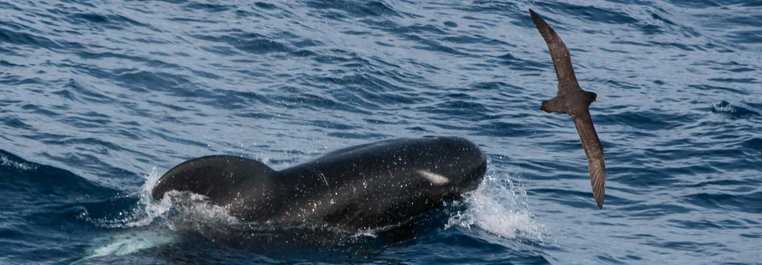This day began pleasantly enough, sunny with a fresh wind from the west, more or less from our direction of travel. The moderate swell and wind waves were easily navigated by our ship, the National Geographic Explorer with just enough motion to convince us we were in the open ocean.
Days at sea, particularly toward the end of a voyage have been a time for catching up, reflection and perhaps some photography and bird watching. Our shipboard schedule was sprinkled with presentations, meals and photography workshops, but there were always people on watch so that we could take advantage of extraordinary opportunities to experience nature far from the beaten path. One such opportunity occurred today!
In the distance, a concentration of seabirds, near the surface of the ocean was noted, a sure sign of feeding. Dark shapes appeared from beneath the water, with a blow and sometimes a splash. These were long-finned pilot whales, a dozen, twenty, perhaps fifty. At first it was difficult to tell how many there were. A conservative estimate could be calculated by multiplying the number seen at any given moment by three, to count the ones under water … a hundred, two hundred, perhaps three or four hundred whales! We were astonished to have seen this incredible number at one time as these giant herds are usually more spread out. There were not only adult whales, but very small, young-of-the-year as well.
Long-finned pilot whales are deep divers. In the dark waters, deep below the surface, below the light, they hunt for squid and fish, perhaps with the help of their large melon head and echolocation. And these pilot whales were not alone. When we have seen long-finned pilot whales at these latitudes we have sometimes seen the beautiful hourglass dolphin accompanying them, a boldly patterned species with an elongated hourglass of white against the black on their sides. It’s hard to describe their beauty, you must see them. The hourglass dolphin is a pen and ink drawing by a master artist. They too feed on fish and squid, but their association or cooperation with the pilot whales is a story of few details at present. The hourglass dolphins have not been well studied, as they occur off shore between about 45 and 60 degrees south latitude where the ocean runs cold, wild and circles the world.
We were fortunate to have two NOAA researchers aboard using the National Geographic Explorer as a platform for their whale research. Much was explained this night at our recap. Some of the unofficial scuttlebutt reported squid tentacles hanging out of the mouths of surfacing whales driving the sea birds into a further frenzy. So much for catching up and reflection, Maybe tomorrow, maybe not at all.









